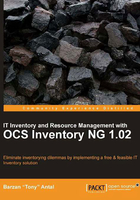
Summary
In this introductory chapter, we have kick started our venture to understand and solve IT inventory requirements that exist in almost every firm in the real world. We presented the practical uses of having a mature inventory coupled with a healthy database ready to serve requests. No doubt we have realized that implementing such an integrated process is a necessary method before the situation gets out of control.
Together we created a list of criteria and expectations that we demand from our integrated inventory solution. By having all of these in place, the way work is done inside an organization becomes streamlined. Moreover, we can eliminate unnecessary paperwork. The responsible parties that will be managing their own departments will be able to get their tasks done even more efficiently.
We have realized that centralization is the best solution for an inventory and asset management system. After analyzing and comparing two of the most popular networking and distributed computing paradigms with each other, we backed up our suppositions. We have learned the mechanism of the client-server model as well as the peer-to-peer paradigm architecture.
We have set the scene for the book by presenting an incentive on OCS Inventory NG and overviewing the set of features it brings to the table. Moreover, we can tackle this situation further and build from ground up our OCS-NG inventory on a step-by-step basis.
So let's go ahead and begin setting up our OCS-NG central management server.